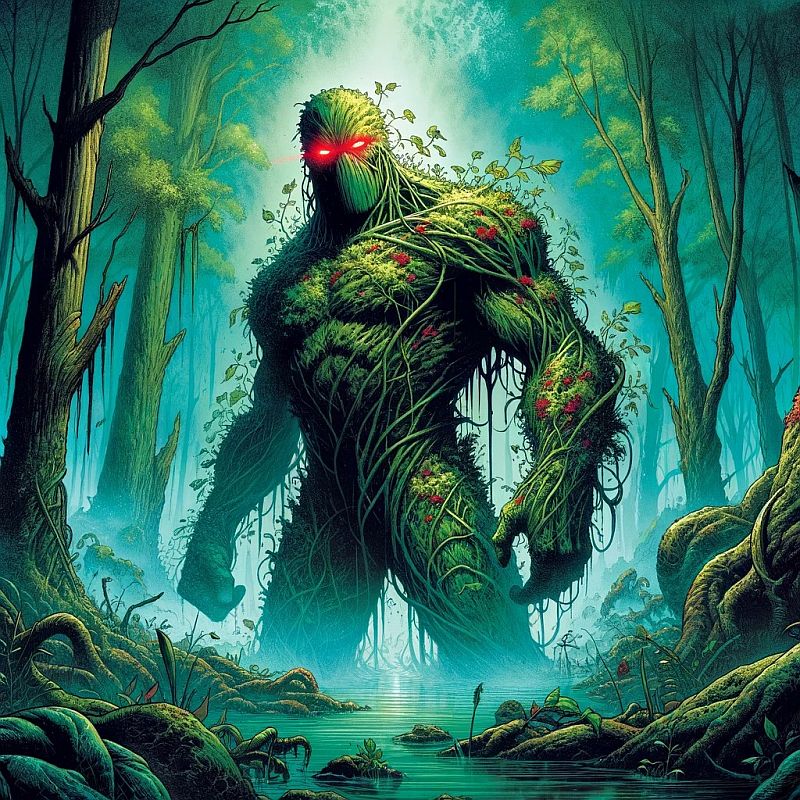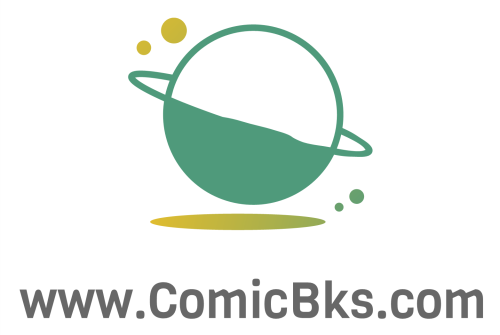
Swamp Thing, a fictional superhero in American comic books published by DC Comics. Swamp Thing has appeared in several horror and fantasy-themed adaptations, including comic books, films, and television series. Created by writer Len Wein and artist Bernie Wrightson, the character first appeared in “House of Secrets” #92 (July 1971) in a stand-alone horror story set in the early 20th century. The character then received a self-titled series in the 1970s, where he became a green, elemental creature who fights to protect his swamp home, the environment, and humanity from various supernatural or terrorist threats.
Swamp Thing’s character has been explored in various media:
- Comic Books: Swamp Thing’s comic book series are known for their deep philosophical themes and environmental messages. The character’s mythology was significantly expanded by writer Alan Moore in the 1980s, where he introduced the concept of the “Green,” a force that connects all plant life on Earth, and redefined Swamp Thing’s origins, making him a plant elemental creature rather than a human transformed into a plant monster.
- Movies: Swamp Thing has been adapted into live-action films. The first movie, titled “Swamp Thing,” was released in 1982 and directed by Wes Craven. It was followed by a sequel, “The Return of Swamp Thing,” in 1989.
- Television: The character has appeared in several TV series, including a live-action series in the early 1990s and a more recent live-action series launched by DC Universe in 2019, which blends horror and fantasy elements. There have also been animated appearances.
- Cultural Impact: Over the years, Swamp Thing has become a cultural icon representing ecological issues and the complexities of humanity’s relationship with the natural world. The character has been praised for its innovative use of horror and fantasy to explore deep themes and has a dedicated fan base.
Swamp Thing’s stories often delve into dark and intricate narratives, combining horror, fantasy, and science fiction elements with poignant environmental and philosophical themes. Whether you’re exploring his comic book adventures, watching one of the films, or diving into a TV adaptation, Swamp Thing offers a unique and thought-provoking take on the superhero genre.
Swamp Thing is Dr. Alec Holland, a scientist who transforms into the Swamp Thing after a violent incident in his laboratory in the swamp. The transformation is initially depicted as a tragic accident involving a formula intended to stimulate plant growth, which instead turns Holland into a plant-based entity with the memories and personality of the scientist. Over the years, the character’s origin and nature have evolved, with later writers like Alan Moore reimagining him not as a transformed human but as a plant elemental—a guardian of the natural world with a deep connection to all plant life on Earth, known as “The Green.”
This elemental creature possesses various powers, including superhuman strength, the ability to control plant life, rapid regeneration, and immortality. Swamp Thing’s stories often explore themes such as environmentalism, the interconnectedness of all living things, and the human condition, blending horror and fantasy with ecological and philosophical underpinnings.
Swamp Thing has been featured in various media outside of comic books, including films, television series, and animated shows. The character’s first live-action adaptation was in Wes Craven’s 1982 horror film “Swamp Thing,” which was followed by a sequel, a live-action television series in the early ’90s, and a USA Network series in the mid-’90s. More recently, a new live-action series was launched on the DC Universe streaming service in 2019, emphasizing horror elements and the character’s dark origins.
Throughout its history, Swamp Thing has been praised for its sophisticated storytelling, complex character development, and its ability to tackle serious themes through the lens of horror and fantasy. The character’s deep connection to the Earth and its ecosystems has made Swamp Thing a unique and enduring figure in the realm of comic book superheroes.
Diving deeper into the Swamp Thing lore, the character’s narrative complexity is further enriched by the intricate relationships and conflicts he navigates. Central to Swamp Thing’s journey is his struggle with his own identity and humanity. Transformed into a creature of the swamp, Alec Holland wrestles with the loss of his human life and the acceptance of his new existence as the Swamp Thing. This internal conflict is a recurring theme, exploring the notion of what it means to be human and where the line between man and monster truly lies.
The series has also been a platform for introducing a diverse cast of characters, both allies and adversaries, that deepen the world Swamp Thing inhabits. Characters such as Abby Arcane, the love interest of Swamp Thing, and her villainous uncle, Anton Arcane, a necromancer obsessed with immortality, play significant roles. These relationships are pivotal, as they not only provide emotional depth but also drive the narrative forward, presenting Swamp Thing with challenges that test his resolve and commitment to protecting all forms of life.
The Swamp Thing mythos delves into the realm of the arcane and the mystical. With the introduction of concepts such as the Parliament of Trees, a council of past elemental protectors, and the Rot, an antithetical force to the Green representing death and decay, the series crafts a rich tapestry of the supernatural that coexists with the natural world. These elements, along with others like the Red, which connects all animal life, and the Clear, associated with aquatic life, create a complex ecosystem of forces that Swamp Thing must navigate and protect.
Swamp Thing’s stories are not just battles against external threats but also meditations on ecological and environmental themes. Through its protagonist, the series poses poignant questions about conservation, the impact of human activity on the environment, and the interconnectedness of all living things. Swamp Thing acts as a guardian not just in a physical sense, but also as a symbol of the urgent need to preserve the natural world.
In terms of its influence and legacy, Swamp Thing has left an indelible mark on the landscape of comic books and beyond. The series’ willingness to tackle profound themes, its innovative use of horror and fantasy elements, and its impact on the development of mature and sophisticated storytelling in comics have been widely acknowledged. As a testament to its enduring appeal, Swamp Thing continues to inspire new generations of writers, artists, and fans, cementing its place as a seminal work in the canon of graphic literature.
As we look toward the future of “Swamp Thing,” it’s clear that this character and series hold endless possibilities for exploration and storytelling. With its rich blend of horror, fantasy, ecological themes, and deep philosophical questions, Swamp Thing remains a fertile ground for new narratives that can continue to challenge, entertain, and provoke thought among readers. The evolving concerns about our environment and our relationship with the natural world only add to the relevance of Swamp Thing’s message, making it more pertinent than ever.
The legacy of Swamp Thing is not just in the stories that have been told but in the potential for what is yet to come. As the comic book industry and its audiences grow and change, there is a tremendous opportunity for writers and artists to delve into the complex mythology of Swamp Thing, introducing new characters, conflicts, and themes that reflect the concerns and hopes of contemporary society. The character’s journey is far from over, and there are many more tales to be told from the depths of the swamp.
As we anticipate the future adventures of Swamp Thing, we invite you, the readers, to share your thoughts and expectations. What aspects of Swamp Thing’s world do you find most compelling? Are there particular stories or themes you would like to see explored in future comics? Your insights and desires can help shape the trajectory of Swamp Thing’s legacy. Please leave a comment with your thoughts, ideas, and what you hope to see next in the saga of Swamp Thing. Your engagement is not only welcomed but essential in keeping the spirit of Swamp Thing alive and thriving in the hearts of fans old and new.
FAQ: Exploring Swamp Thing
1. Where should I start reading Swamp Thing comics?
- Answer: For new readers, starting with the Alan Moore run on “Swamp Thing” (beginning with Saga of the Swamp Thing #20) is highly recommended. This era is celebrated for redefining the character and the series, introducing complex themes and the iconic environmental and supernatural elements that define Swamp Thing. DC Comics and other comic book retailers offer collected editions of these influential issues.
2. Are there any Swamp Thing adaptations in film or television?
- Answer: Yes, Swamp Thing has been adapted into several films and TV series. The most recent TV adaptation, which aired in 2019, delves into the horror elements of the comics and explores the origins of Swamp Thing. Check streaming platforms like HBO Max or Netflix, as offerings may vary by region and over time.
3. Can I read Swamp Thing comics digitally?
- Answer: Absolutely. Digital platforms like ComiXology, DC Universe Infinite, and others offer vast collections of Swamp Thing comics. These services often provide access to both classic issues and the latest runs, making it easy to explore the character’s evolution over the years.
4. What other characters or series are related to Swamp Thing?
- Answer: Swamp Thing is closely tied to other characters and series within the DC Universe, especially within the dark or supernatural genres. Characters like John Constantine, who first appeared in the Swamp Thing series, lead their own series “Hellblazer.” The Justice League Dark series also features Swamp Thing alongside other mystically inclined characters like Zatanna and Deadman, fighting supernatural threats.
5. Where can I find merchandise or collectibles?
- Answer: For merchandise and collectibles, official DC Comics shops, conventions, and online retailers like eBay or Etsy are great places to find Swamp Thing figures, posters, and apparel. Specialty stores like Sideshow Collectibles occasionally release high-end statues and figures for collectors.
6. Are there any community forums or fan sites for Swamp Thing fans?
- Answer: Yes, fan forums like Reddit’s r/DCcomics or dedicated Swamp Thing fan sites offer communities for discussion, fan art, and news. These can be great resources for connecting with other fans, discovering fan theories, and staying up-to-date on Swamp Thing-related news.
7. How can I stay informed about new Swamp Thing projects or releases?
- Answer: Following official DC Comics social media accounts and subscribing to comic book news websites like Comic Book Resources (CBR) or Newsarama can keep you informed about upcoming Swamp Thing projects, comic book releases, and adaptations.
Your Contribution
We hope this FAQ section helps guide your exploration of Swamp Thing and the broader universe he inhabits. If you have further questions, insights, or recommendations for fellow fans, please share them in the comments below. Your contributions help build a vibrant community of enthusiasts eager to delve deeper into the mysteries of the swamp and beyond.

